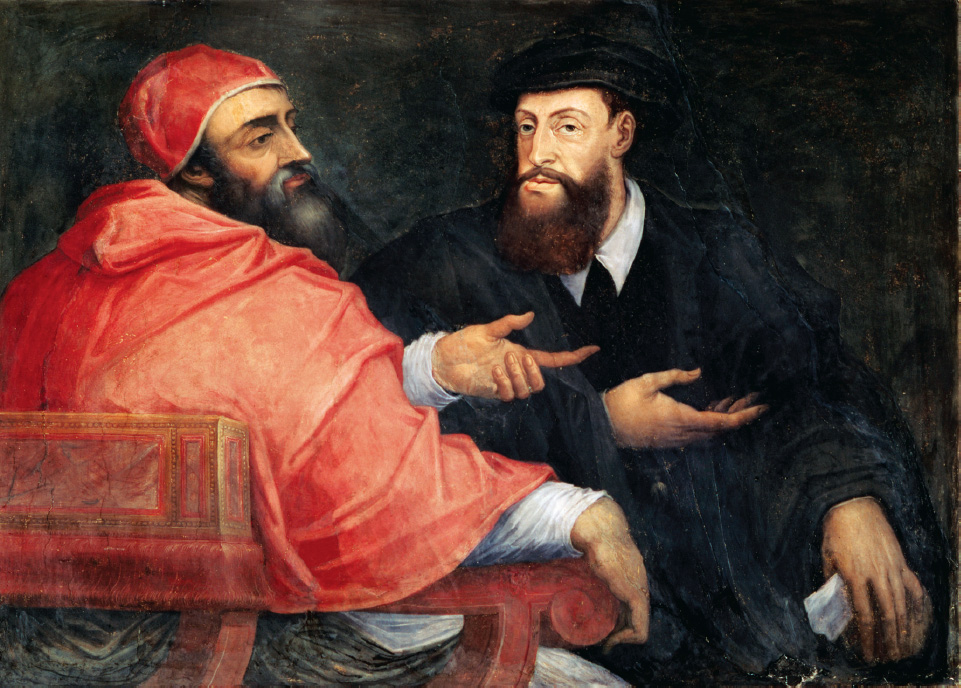A History of Western Society: Printed Page 405
A History of Western Society, Value Edition: Printed Page 415
Religious Wars in Switzerland and Germany
In the sixteenth century the practice of religion remained a public matter. The ruler determined the official form of religious practice in his (or occasionally her) jurisdiction. Almost everyone believed that the presence of a faith different from that of the majority represented a political threat to the security of the state, and few believed in religious liberty.
Luther’s ideas appealed to German rulers for a variety of reasons. Though Germany was not a nation, people did have an understanding of being German because of their language and traditions. Luther frequently used the phrase “we Germans” in his attacks on the papacy. Luther’s appeal to national feeling influenced many rulers otherwise confused by or indifferent to the complexities of the religious matters of the time. Some German rulers were sincerely attracted to Lutheran ideas, but material considerations swayed many others to embrace the new faith. The rejection of Roman Catholicism and adoption of Protestantism would mean the legal confiscation of lush farmlands, rich monasteries, and wealthy shrines. Thus many political authorities in the empire became Protestant in part to extend their financial and political power and to enhance their independence from the emperor.
Charles V was a vigorous defender of Catholicism, so it is not surprising that the Reformation led to religious wars. The first battleground was Switzerland, which was officially part of the Holy Roman Empire, though it was really a loose confederation of thirteen largely autonomous territories called cantons. Some cantons remained Catholic, and some became Protestant, and in the late 1520s the two sides went to war. Zwingli was killed on the battlefield in 1531, and both sides quickly decided that a treaty was preferable to further fighting. The treaty basically allowed each canton to determine its own religion and ordered each side to give up its foreign alliances, a policy of neutrality that has been characteristic of modern Switzerland.

Trying to halt the spread of religious division, Charles V called an Imperial Diet in 1530, to meet at Augsburg. The Lutherans developed a statement of faith, later called the Augsburg Confession, and the Protestant princes presented this to the emperor. (The Augsburg Confession remains an authoritative statement of belief for many Lutheran churches.) Charles refused to accept it and ordered all Protestants to return to the Catholic Church and give up any confiscated church property. This demand backfired, and Protestant territories in the empire — mostly northern German principalities and southern German cities — formed a military alliance. The emperor could not respond militarily, as he was in the midst of a series of wars with the French: the Habsburg-Valois wars (1521–1559), fought in Italy along the eastern and southern borders of France and eventually in Germany. The Ottoman Turks had also taken much of Hungary and in 1529 were besieging Vienna.
The 1530s and early 1540s saw complicated political maneuvering among many of the powers of Europe. Various attempts were made to heal the religious split with a church council, but stubbornness on both sides made it increasingly clear that this would not be possible and that war was inevitable. Charles V realized that he was fighting not only for religious unity, but also for a more unified state, against territorial rulers who wanted to maintain their independence. He was thus defending both church and empire.
Fighting began in 1546, and initially the emperor was very successful. This success alarmed both France and the pope, however, who did not want Charles to become even more powerful. The pope withdrew papal troops, and the Catholic king of France sent money and troops to the Lutheran princes. Finally, in 1555 Charles agreed to the Peace of Augsburg, which, “in order to bring peace into the holy empire,” officially recognized Lutheranism. The political authority in each territory was permitted to decide whether the territory would be Catholic or Lutheran and was ordered to let other territories “enjoy their religious beliefs, liturgy, and ceremonies as well as their estates in peace.” Most of northern and central Germany became Lutheran, while the south remained Roman Catholic. There was no freedom of religion within the territories, however. Princes or town councils established state churches to which all subjects of the area had to belong. Dissidents had to convert or leave, although the treaty did order that “they shall neither be hindered in the sale of their estates after due payment of the local taxes nor injured in their honor.”5 Religious refugees became a common feature on the roads of the empire, though rulers did not always let their subjects leave as easily as the treaty stipulated.
The Peace of Augsburg ended religious war in Germany for many decades. His hope of uniting his empire under a single church dashed, Charles V abdicated in 1556 and moved to a monastery, transferring power over his holdings in Spain and the Netherlands to his son Philip and his imperial power to his brother Ferdinand.